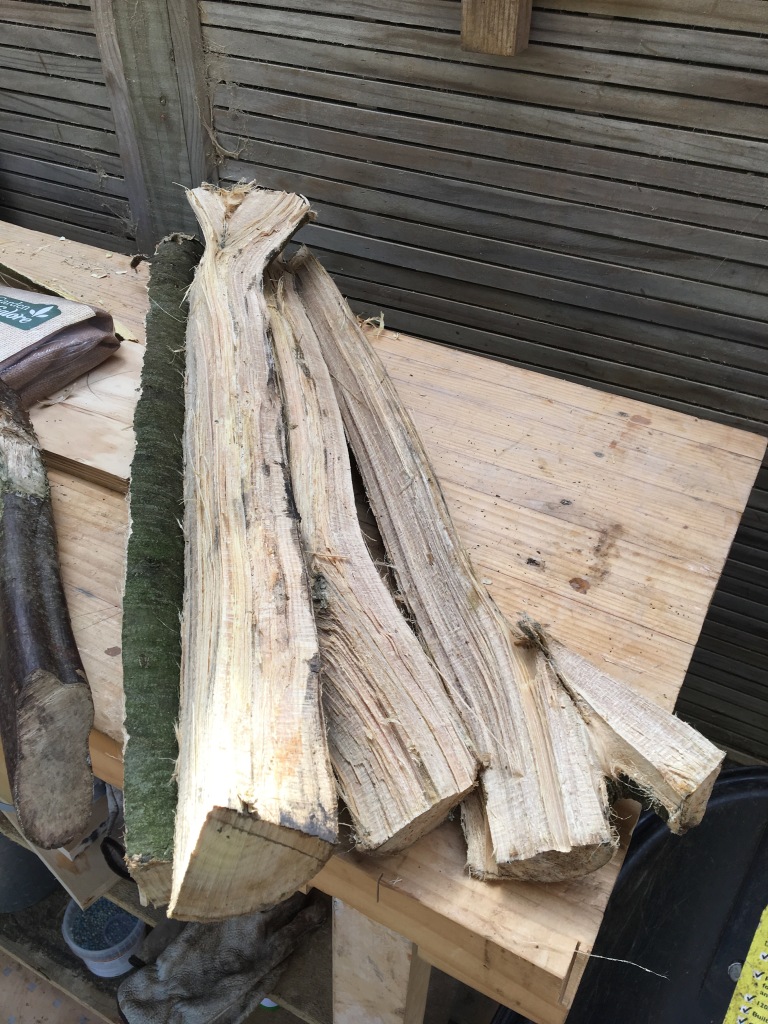Green woodworking part two.
As we have cleared around the section, we have taken out some awkward branches, and in one case, a tree; a ribbon wood (I will edit this later with the species). I’ve been using the ribbon wood branches and logs as trials as I learn to use new tools and new ways of doing things. Given that I need somewhere to sit a crude bench (a very crude bench) has been the project.
Am I a froe bro now?

I have reeved some bit of the timber using a recently purchased froe. A froe is probably technically an axe, with a long cutting blade, but its handle at right angles to the working edge. The idea is that you can use a wooden club or hammer to force the blade down through the length of a piece of wood, using the handle to steer the blade in the desired direction. You can see from the photo that there is a fair amount of the blade sticking out both sides of the log, so there is plenty of striking surface to hit with a mallet to help force the blade through the log. Logs much bigger than this will likely need a different splitting technique.
Using a froe was a bit trickier that I thought it would be for a few reasons. Firstly, I don’t have a “break,” a framework that holds and positions the wood in a upright position for me to reeve it. I managed to overcome this by the expedient of using other loose logs to help position the log I was working on. (see photo) Given various photos and drawings of of breaks being used by craftspeople found on the web, this was probably a typical solution anyway; breaks more often than not resemble bunches of timber that have been attached together. It feels like a lot of innovation and improvisation going on with breaks, but that might need further investigation of the tradition to be sure.

The second issue has been that the wood itself is somewhat knotty and twisted. Watch videos of people using a froe online, and they are typically working with very straight-grained pieces of timber. Sometimes shorter than I was attempting, but mostly just straighter grained. That sort of wood will split easier and cleaner no matter who is using the tool.
The third issue was that the froe itself wasn’t that sharp. I am not sure about this aspect of things. At least some people talk of a froe as a splitting implement, so it needn’t be very sharp; the whole point is to pull the wood apart along the grain by forcing the froe down its length, with the froe acting as a wedge, rather than as a slicing tool; the width of the tool is doing the work, rather than the edge. Splitting axes work along similar lines. However, some videos and discussions I’ve seen do suggest a bit more of a slicing action, and that would certainly assist with knots etc. Watch videos of woven wooden basket makers, one gets the sense that the froe slices to some extent, and doesn’t just split. The current state of play is that the froe is not that sharp, but I have sharpened it somewhat. It needs some more work however.
The upshot was some reeved pieces of timber of various shapes and sizes. Fairly crudely split in some cases, with knots, and not great bits of consistency along the lengths, but nevertheless, split.
Shaping and pegging
I now regret somewhat the next bit of work I DIDN’T do, which was to shape the wood. The slabs were left very rough. In retrospect, I should have done something to the larger slabs before I got too carried away pegging/dowelling them together. The reason I didn’t do this was mostly because the only hand tools I had were planes, chisels and axes, none of which were quite right. Being green wood, and rough, the planes were pretty much useless. They didn’t get enough bite, and they clogged up quickly with sticky green wood if they did.

My two axes, the shingling axe which I have been using for spoon carving, and the rescued cheap axe, both had their own issues. The shingling axe is very geared to use by one hand. (See the photo: I have flipped the head on this axe for left hand use.) I quickly found it frustrating to use to shape a larger rough log. Its bite is too big once you get to the shoulder, I couldn’t alternate its use, and it just didn’t have the right weight behind the blade. Plus its a bit light for me. Still great for finer work and spoons, and it did okay on the legs, but it is not ideal.

The rescue axe, which I found rusting in our open air shed, simply isn’t sharp enough, needs serious work, probably a new handle, and is just generally a bit useless. It feels underpowered for its weight, and really isn’t a carpenters axe anyway, as it is designed for kindling splitting. Still, in the interests of economy I’ll persevere with it, but it will need a serious bit of sharpening to be productive, and my suspicion is that a carpenters axe of some sort will be needed.

Axes and axe feel
One of the things that is becoming apparent is that the feel of an axe in use is may well be important. I recently went into a store that sold some rather expensive Swedish and German made axes, and even just swinging them without hitting anything was comfortable and balanced. One axe had a handle that was oversized for my hand, another that felt right, but a little light, etc etc, but pretty much all of them felt better than the cheap “rescue axe” which feels insecure, unbalanced and geared towards the splitting of kindling.
Now, this “feel” might all be somewhat subjective and prone to bias. After all, swinging a $200+ brand name carpenter’s axe in a store is always going to feel better than wrestling with a found cheap axe that has barely had any recovery work done on it. There is just a whole lot of expectations and psychological dispositions going on. That said, the positioning of the hand below the blade means the weight is more liable to swing than slice, and the shorter blade length means its more liable to act like a wedge than a slicing blade. But at this point I am working without first person knowledge; its “know that” rather than “know how”; I know the theory having read some bits and pieces about the use of axes, and listened to experienced people talk about using them, but I don’t actually know the practice having never used one myself. Until I start using a carpenter’s axe proper, I am not really in a good position to judge. All this may or may not be an excuse to buy a nice axe.



0 Comments